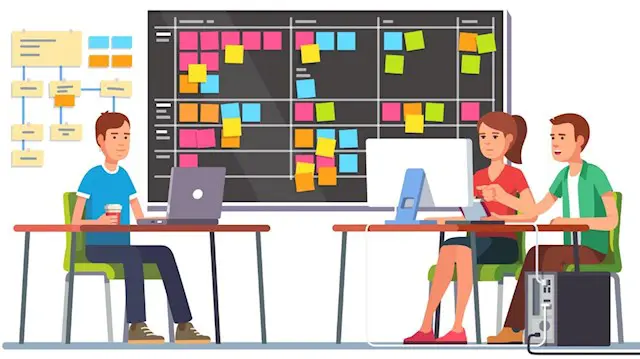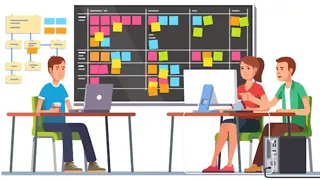
User Story Mapping Workshop - Scrum Product Owner
Workshop to create a User Story Map. Agile Vision and Product backlog management. Advanced Scrum. Apply it right away.
Scrum Success
Summary
- Certificate of completion - Free
- Reed courses certificate of completion - Free
Add to basket or enquire
Overview
Did you realize how difficult is to visualize the product as a whole when working with a typical Flat Product Backlog?
A solution is User Story Mapping. A user story map is a simple idea for Agile teams, is about arranging user stories into a helpful shape. User Story mapping is used by top companies of any industry to visualize goals with activities and agree fast on how to achieve them with minimum versions of the product.
This workshop will guide you step by step with a realistic example that you can also follow with your own project.
If you have no knowledge about User stories, don't worry, we will start by writing user stories, applying formats for acceptance criteria, understanding the different sizes of user stories, and splitting the stories to the right size using proven techniques and approaches. You will see many examples of how to apply these techniques.
Certificates
Certificate of completion
Digital certificate - Included
Reed courses certificate of completion
Digital certificate - Included
Will be downloadable when all lectures have been completed
Curriculum
Course media
Description
What you will learn?
-
Persona
-
Product Vision
-
Elevator Pitch
-
User Stories:
-
Why the Product backlog is perishable
-
What are User Stories?
-
Different Sizes of User Stories
-
What is the Acceptance criteria?
-
Formats to write the Acceptance Criteria
-
Split User Stories with Divide and conquer technique
-
Create good User Stories based on INVEST.
-
Guidelines to Split stories
-
Split User Stories with SPIDR approach
-
-
Definition of Ready
-
User Story Mapping:
-
Flat Product Backlog vs. User Story Mapping
-
User Story Mapping, goals, activities, cards
-
Adding Personas to User Story Mapping
-
Prioritize with Story Mapping
-
Define MVP and Releases
-
What you will you create?
In this workshop, you will create a complete User Story Mapping for a realistic example, for your own project, or both.
-
A Persona
-
The Product Vision
-
The Product elevator pitch
-
Write User stories, split them, and write acceptance criteria
-
Create the definition of Ready for your team using a template
-
A Product Backlog
-
A complete refined User Story Mapping with goals, activities, users, and cards.
-
Define the MVP for your product and releases
Why taking the class? What you will gain?
-
Skills for creating, splitting, and managing great user stories.
-
Become more effective in planning your sprints, roadmaps and interact with stakeholders and developers.
-
Skills to create User Story mapping.
-
Tips to facilitate a User Story Mapping Session.
-
A Story Mapping for your own Products.
-
Interaction and exposure for using one of the best tools.
This class can always be improved, so if you have any topic that you would like to know more, please let me know so I can see to include it in this class or in future courses.
What are you waiting? Start this course now
About me
Hi, my name is Ignacio.
My main goal is to help you with new knowledge that you can apply at work and be a successful and professional leader.
I am a Certified Agile Team Coach. I led, coached, led, and managed Agile projects and scrum teams since 2005 for customers from all over the world.
During my career with intensive learning, I got many advanced scrum certifications including Certified Scrum Professional Scrum Master, Certified Professional Scrum Product Owner, and Certified Agile Leadership.
I worked 15 years as a Professor for Agile Methodologies and Systems design.
I love to teach Agile and Scrum and I designed a lot of hours of training that I am bringing online. I prefer to teach with games and activities that can simulate the real world.
I trained hundreds of students in Agile that became top professionals in the industry.
Teaching what I learned in my 20 years of experience allows the students to gain realistic learning that they can apply at work.
Who is this course for?
-
This course is specifically for:
-
People familiar with Agile, Scrum, and User Stories who want to improve and learn new techniques
-
People that have problems organizing the Product Backlog and planning releases and roadmaps
-
People that like a activities and workshop style
-
Business people, managers that want to learn how Agile would help them
-
Product Owners, Product Managers, Leaders, Designers, UX, Scrum Masters, Agile Coaches.
-
Developers, Project Managers, Business Analysts, Solution Architects, Enterprise Architects, Data Base Administrators, and basically anyone interested in learning more about Agile.
This course is not suitable for:
-
People with no knowledge of Scrum, Agile. Please start with my course: Agile & Scrum in Depth: Guide, Simulation and Best Practices
-
People who want a method to write detailed requirements and comprehensive documentation. This technique is more about talking than writing.
-
People that want to take certifications.
-
Requirements
Agile and Scrum knowledge is recommended.
Career path
Product Owner, Scrum Master, Agile Coach
Questions and answers
Currently there are no Q&As for this course. Be the first to ask a question.
Reviews
Currently there are no reviews for this course. Be the first to leave a review.
Legal information
This course is advertised on reed.co.uk by the Course Provider, whose terms and conditions apply. Purchases are made directly from the Course Provider, and as such, content and materials are supplied by the Course Provider directly. Reed is acting as agent and not reseller in relation to this course. Reed's only responsibility is to facilitate your payment for the course. It is your responsibility to review and agree to the Course Provider's terms and conditions and satisfy yourself as to the suitability of the course you intend to purchase. Reed will not have any responsibility for the content of the course and/or associated materials.


